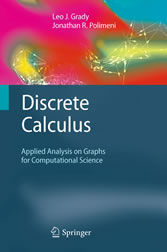Suchen und Finden
Preface
6
Contents
7
Acronyms
12
Discrete Calculus: History and Future
14
Discrete Calculus
14
Origins of Vector Calculus
15
Origins of Discrete Calculus
16
Discrete vs. Discretized
17
Complex Networks
19
Content Extraction
20
Organization of the Book
21
Intended Audience
21
A Brief Review of Discrete Calculus
23
Introduction to Discrete Calculus
24
Topology and the Fundamental Theorem of Calculus
25
Differential Forms
27
Exterior Algebra and Antisymmetric Tensors
28
The Vector Spaces of p-Vectors and p-Forms
28
Manifolds, Tangent Spaces, and Cotangent Spaces
31
The Metric Tensor: Mapping p-Forms to p-Vectors
34
Differentiation and Integration of Forms
37
The Exterior Derivative
37
The Poincaré Lemma
41
The Hodge Star Operator
43
The Codifferential Operator and the Laplace-de Rham Operator
47
Differential Forms and Linear Pairings
48
Discrete Calculus
49
Discrete Domains
50
Orientation
53
The Incidence Matrix
55
Chains
56
The Discrete Boundary Operator
57
Discrete Forms and the Coboundary Operator
59
Primal and Dual Complexes
61
The Role of a Metric: the Metric Tensor, the Discrete Hodge Star Operator, and Weighted Complexes
65
The Metric Tensor and the Associated Inner Product
65
The Discrete Hodge Star Operator
66
Weights
68
The Volume Cochain
68
The Dual Coboundary Operator
70
The Discrete Laplace-de Rham Operator
71
Structure of Discrete Physical Laws
74
Examples of Discrete Calculus
74
Fundamental Theorem of Calculus and the Generalized Stokes' Theorem
76
Generalized Stokes' Theorem on a 1-Complex
76
Comparison with Finite Differences Operators
80
Generalized Stokes' Theorem on a 2-Complex
82
Generalized Stokes' Theorem on a 3-Complex
83
The Helmholtz Decomposition
84
Algorithm for Computing a Helmholtz Decomposition of a Flow Field
87
Matrix Representation of Discrete Calculus Identities
88
Integration by Parts
88
Other Identities
89
Elliptic Equations
90
Variational Principles
93
Diffusion
93
Advection
97
Concluding Remarks
99
Circuit Theory and Other Discrete Physical Models
101
Circuit Laws
103
Steady-State Solutions
104
Dependent Sources
107
Energy Minimization
109
Power Minimization with Nonlinear Resistors
111
AC Circuits
111
Connections Between Circuit Theory and Other Discrete Domains
114
Spring Networks
114
Random Walks
116
Gaussian Markov Random Fields
120
Tree Counting
122
Linear Algebra Applied to Circuit Analysis
127
The Delta-Wye and Star-Mesh Transforms
127
Minimum-Degree Orderings
129
Conclusion
131
Applications of Discrete Calculus
133
Building a Weighted Complex from Data
134
Determining Edges and Cycles
135
Defining an Edge Set
135
Edges from an Ambient Metric
136
Edges by k-Nearest Neighbors
137
Edges from a Delaunay Triangulation
137
Adding Edges via the Watts-Strogatz Model
137
Defining a Cycle Set
138
Defining Cycles Geometrically: Cycles from an Embedding
139
Defining Cycles Algebraically
140
Cycle Sets and Duality
143
Deriving Edge Weights
144
Edge Weights to Reflect Geometry
144
Edge Weights to Penalize Data Outliers
145
Univariate Data
145
Computing Weights from Multivariate Data
150
Edge Weights to Cause Repulsion
152
Edge Weights to Represent Joint Statistics
153
Deducing Edge Weights from Observations
153
The Underdetermined Case
154
The Overdetermined/Inconsistent Case
155
Obtaining Higher-Order Weights to Penalize Outliers
156
Weights Beyond Flows
158
Metrics Defined on a Complex
159
Conclusion
162
Filtering on Graphs
164
Fourier and Spectral Filtering on a Graph
165
Graphs that Are Not Shift-Invariant
168
The Origins of High Frequency Noise
171
Energy Minimization Methods for Filtering
172
The Basic Energy Minimization Model
172
Iterative Minimization
173
Extended Basic Energy Model
176
The Total Variation Model
177
Filtering with Implicit Discontinuities
179
Filtering with Explicit, but Unknown, Discontinuities
181
Filtering by Gradient Manipulation
183
Nonlocal Filtering
183
Filtering Vectors and Flows
184
Translating Scalar Filtering to Flow Filtering
185
Filtering Higher-Order Cochains
188
Applications
189
Image Processing
189
Regular Graphs and Space-Invariant Processing
189
Space-Variant Imaging
191
Three-Dimensional Mesh Filtering
194
Mesh Fairing
194
Filtering Data on a Surface
196
Geospatial Data
201
Filtering Flow Data-Brain Connectivity
202
Conclusion
206
Clustering and Segmentation
207
Targeted Clustering
208
Primal Targeted Clustering
209
Probabilities Assigned to a Subset
210
Known Labels for a Subset of Nodes
213
Negative Weights
217
Dual Targeted Clustering
218
Dual Algorithms in Three Dimensions
221
Untargeted Clustering
223
Primal Untargeted Clustering
224
Dual Untargeted Clustering
228
Semi-targeted Clustering
229
The k-Means Model
229
Clustering Higher-Order Cells
235
Clustering Edges
235
Targeted Edge Clustering
235
Untargeted Edge Clustering
236
Applications
237
Image Segmentation
237
Social Networks
243
Machine Learning and Classification
244
Gene Expression
248
Conclusion
250
Manifold Learning and Ranking
251
Manifold Learning
252
Multidimensional Scaling and Isomap
253
Laplacian Eigenmaps and Spectral Coordinates
255
Locality Preserving Projections
257
Relationship to Clustering
259
Manifold Learning on Edge Data
259
Ranking
261
PageRank
261
PageRank as Advection
263
HITS
264
Applications
265
Shape Characterization
265
Point Correspondence
268
Web Search
270
Judicial Citation
272
Conclusion
274
Measuring Networks
275
Measures of Graph Connectedness
276
Graph Distance
276
Node Centrality
277
Distance-Based Properties of a Graph
278
Measures of Graph Separability
282
Clustering Measures
282
Small-World Graphs
285
Topological Measures
287
Geometric Measures
289
Discrete Gaussian Curvature
290
Discrete Mean Curvature
291
Applications
293
Social Networks
293
Chemical Graph Theory
294
Conclusion
296
Appendix A Representation and Storage of a Graph and Complex
298
General Representations for Complexes
298
Cells List Representation
298
Operator Representation
299
Representation of 1-Complexes
300
Neighbor List Representation
300
Appendix B Optimization
302
Real-Valued Optimization
303
Unconstrained Direct Solutions
304
Constrained Direct Solutions
305
Optimization with Boundary Conditions
305
Optimization with Linear Equality Constraints
308
Optimization with Linear Inequality Constraints
310
Ratio Optimization
312
Descent Methods
315
Gradient Descent
315
Newton's Method
315
Descent Methods for Constrained Optimization
318
Nonconvex Energy Optimization over Real Variables
319
Integer-Valued Optimization
319
Linear Objective Functions
319
Quadratic Objective Functions
321
Pure Quadratic
321
General Pairwise Terms
323
Higher-Order Terms
325
General Integer Programming Problems
325
Appendix C The Hodge Theorem: A Generalization of the Helmholtz Decomposition
326
The Helmholtz Theorem
326
The Hodge Decomposition
333
Summary of Notation
338
References
341
Index
359
Color Plates
366
Alle Preise verstehen sich inklusive der gesetzlichen MwSt.








